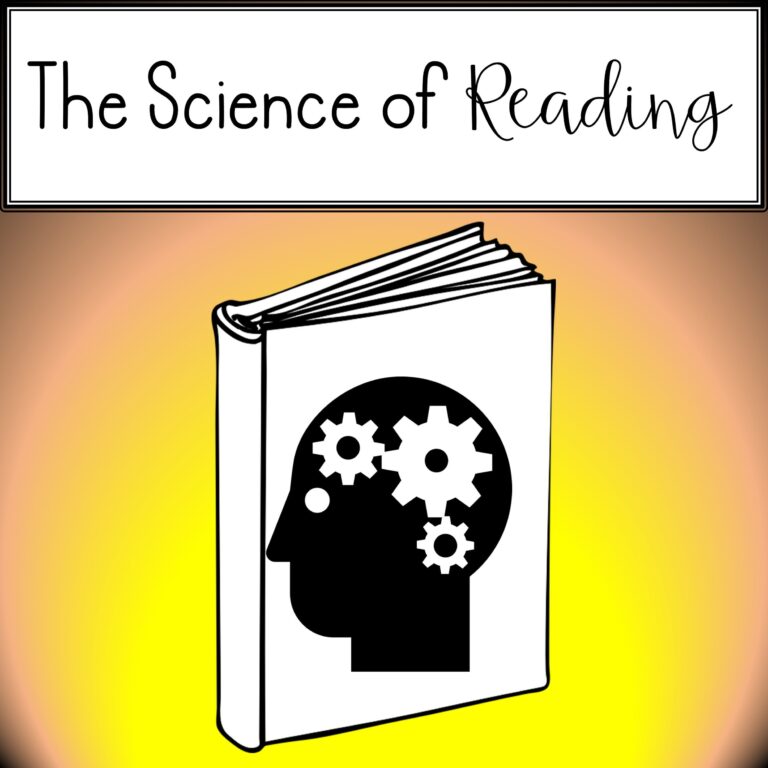
Share This:
For this week’s blog post, I have another incredible guest blogger. I’m thrilled to announce Michelle to you. Michelle Sullivan is the face behind The Colorful Classroom, and she is both incredibly knowledgeable and quite possibly one of the nicest people you will ever meet. In this blog post, she shares some of the debates behind phonemic awareness, and explains how we CAN and SHOULD combine phonemic awareness and phonics. Enjoy!–Savannah
Have you ever heard that phonemic awareness can be done in the dark? Should it be done in the dark? What’s all the buzz about “phonemic awareness with letters”? Isn’t that just phonics?
In this blog post, we’ll dig into what “phonemic awareness with letters” really means, as well as learn how to infuse phonemic awareness skills with phonics instruction.
In 2000, the National Reading Panel identified 5 pillars of effective reading instruction. One of those pillars is Phonemic Awareness.

So, what is phonemic awareness exactly? If you’re a word nerd like me, you’ll appreciate a tip of the hat to etymology. The Greek root “phonema” means “A sound made” – a singular sound. So, when we refer to having phonemic awareness, it means having the ability to recognize and manipulate these “singular sounds” in words. We’re honing in on individual phonemes, or the smallest units of sounds in our language.
Phonemic awareness is indeed oral and auditory, as we’re focusing on sounds. This is why we hear phrases like phonemic awareness “can be done in the dark” or phonemic awareness means “you’re reading with your ears”.
However, the core of being phonemically aware is being able to isolate, blend, segment, and manipulate sounds in words. We call these phonemic awareness skills. These skills are what allow us to ultimately pull print off a page with our eyes when we decode.
While phonemic awareness deals with sounds, another pillar of reading, Phonics, focuses on letters or graphemes that REPRESENT those sounds. Phonics is the instructional method used to help people learn the alphabetic principle of their language. It deals with written language and print; it’s visual AND it’s auditory.
So, we can acknowledge that phonemic awareness and phonics are different, right? Here is where the confusion comes in. Many believe that since phonemic awareness is oral and auditory, attaching letters would just be considered phonics instruction.
Yes and no.
We need to go back to defining our terms.
It is true that when we do phonemic awareness with letters, we are amidst phonics instruction.
However, when you think about phonemic awareness, think about the skills. One would be working on isolating, blending, segmenting, and/or manipulating sounds.
When you think about phonics, think about the systematic approach we take in learning the relationships between the sounds we hear in words and the letters that spell them.
For example, take the word “night”. Even if you SEE the word in print, you’re using phonemic awareness if you can:
So, let’s clarify:
Simply put, phonemic awareness with letters means applying phonemic awareness SKILLS with print attached based on the phonics you’ve taught. Yes, we are working on phonics – but we are working on phonemic awareness simultaneously!
Ultimately, just because you can perform phonemic awareness activities with your eyes shut, it doesn’t mean you must perform phonemic awareness activities with your eyes shut.
First and foremost, it’s important to put bias aside and look at what the research tells us.
Some may assert: “My students LOVE doing oral-only phonemic awareness activities!” – “They’re so good at it!” Yes, this word-play is very fun and it certainly does not hurt anyone.
However, the end goal is not just to be masters at “playing with sounds”. The end goal is to become proficient readers and spellers!
Let’s look at what the National Reading Panel Report has to say about phonemic awareness with letters:
“…From reading outcomes, it can be seen that teaching children to manipulate phonemes with letters created effect sizes almost twice as large as teaching children without letters (d = 0.67 vs. 0.38).”
“Likewise, letters benefited spelling more than no letters, with the effect size almost twice as great (d = 0.61 vs. 0.34). These findings reveal that PA training makes a stronger contribution to reading and spelling performance when the training includes teaching children to manipulate phonemes with letters than when training is limited to speech.”
(National Reading Panel Report, pgs. 2-21 & 2-22)

We see that the efficacy of phonemic awareness with letters is just about DOUBLE that of phonemic awareness without letters. Yes, doubly effective. That’s not just a smidge.
Ideally, as we do phonemic awareness with letters, we also align the words we’re using FOR phonemic awareness with the phonics features we’re currently working on. It shouldn’t be a mish-mosh of randomized words.
Additionally, Linnea Ehri, along with a slew of other researchers, reference the reciprocal relationship between phonemic awareness and phonics. There is an interconnectedness, if you will.
Yes, we do need some basic phonemic awareness as a stepping stone (essentially, the ability to blend and segment) before being able to read and spell even the most basic words. However, having phoneme proficiency is not a prerequisite to learning phonics.
In fact, working on phonemic awareness benefits phonics. While working on phonics improves one’s phonemic awareness. And so, the cycle continues.

Any Louisa Moats fans in the house? I unashamedly hope I’m not the only one jumping up and down. The very title of one of my favorite reference books is just ONE way (ehem, one CRITICAL way) to bridge phonemic awareness with phonics.
We always want to move from Speech to Print.
Simply beginning your phonics lesson with a brief phonemic awareness introduction can be a powerful way to build this connection.
For example, when introducing a new sound (i.e. /b/), we don’t want to start with the grapheme. We’re going to begin with the sound first, and then introduce the grapheme that spells that sound. (Side note: This avoids confusion as we have 26 letters, 44 sounds, and 250+ graphemes in the English language.)
One fun way to do this is to begin with an “I Spy” board. Display different pictures and have students identify the pictures that begin with that sound. (Note: you can also do the same activity, but change the position of the sound.)
An alternative is to generate words (with or without students, depending on ability) and create your own word list of words that begin with such sound. If charting, you can sketch some of the words, if applicable. If you’re working with tech, you can pull up a quick Google image to bring the word list to life, especially considering many words may likely not be within the students’ decoding abilities yet.

Have you used sound boxes, chips, felt squares, or other manipulatives when working on phonemic awareness? An easy way to infuse phonics here is to ask students eliciting questions regarding particular phonemes.
In this case, the words you’re using should either:
When working on digraphs, trigraphs, or even vowel teams, for example, we may stack 2-3 Unifix cubes or utilize 2-3 chips to represent a single phoneme that consists of multiple letters.
For example, in the word “scratch”, the student may represent this word with 5 chips within 5 boxes, as the word has 5 phonemes. The teacher, then, can ask eliciting questions:
When the student responds with “-tch”, the student and/or teacher can stack 3 Unifix cubes together to acknowledge 3 letters that represent 1 sound.

In the word “show”, the student may represent this word with 2 chips within 2 boxes, as the word has 2 phonemes. Then, the teacher, may ask eliciting questions, such as:

Even if the student does not answer correctly, this is an opportunity for corrective feedback and explicit instruction to reinforce recently learned phonics rules. Then, the student and/or teacher can group 2 counters/chips in one box to acknowledge 2 letters that represent 1 sound.
(Be sure to grab my freebie filled with several different blending boards!)
Keeping things even simpler, remember that any time students are practicing blending in phonics, they are utilizing phonemic awareness skills with letters.
As a scaffold, if students are having difficulty blending a word, we can explicitly underline each grapheme and pay close attention to the letters representing a particular sound.

Another option is to mark up words in a special way. For example, if students need it, we can mark words with sound dots. We can even teach students how to code words (i.e. box the digraph, mark the vowel with a breve, etc.).

If you’re into analogies, blending is to decoding just as segmenting is to encoding. Any time students are practicing encoding, or spelling, in phonics, they are utilizing the phonemic awareness skill: segmentation.
As a scaffold, if students are having difficulty spelling a word, we can utilize manipulatives (such as chips, cubes, pop-it fidgets, or even a slinky) to stretch out and segment each sound first.
Then, we can teach students to draw a line for each sound they hear. After that, students can work through one phoneme at a time, attempting to assign the proper grapheme to each sound they hear.

For an even heavier scaffold during dictation, some teachers even chose to provide students with pre-made dictation sheets with lines already available for each pre-planned word.
Another alternative to drawing lines is creating your own sound boxes with sticky notes. It can even be helpful to work on dictation on sheets with pre-made sound boxes. This all reinforces that reciprocal relationship between phonemic awareness and phonics.

My hope is you walk away from this blog post understanding that phonemic awareness with letters is not an oxymoron. Utilizing phonemic awareness simply means we’re tapping into the skills of isolating, blending, segmenting and manipulating sounds. When we attach letters, the benefits are doubly effective.
We saw several examples of what bridging these two pillars of literacy could potentially look like in action. Now, you can feel confident infusing “phonemic awareness with letters” into your instructional time, knowing it’s what’s best to advance your students’ reading and spelling skills!

Michelle Sullivan, the face behind The Colorful Classroom, has over a decade of experience immersed in the literacy realm. During that time, she has held the roles of reading interventionist and literacy coach – both at the elementary level. She is OG trained, a lifelong learner, and has a passion for equipping teachers with tips, tools, and strategies for strong literacy instruction. You can find her on Instagram @michelle_thecolorfulclassroom or through her website: https://www.michelleandthecolorfulclassroom.com/ .
Share This:

Savannah Campbell is a K-5 reading specialist. She has taught her entire 12-year teaching career at the school she went to as a child. She holds two master’s degrees in education from the College of William and Mary. Savannah is both Orton-Gillingham and LETRS trained. Her greatest hope in life is to allow all children to live the life they want by helping them to become literate individuals.

Savannah Campbell is a K-5 reading specialist. She has taught her entire 12-year teaching career at the school she went to as a child. She holds two master’s degrees in education from the College of William and Mary. Savannah is both Orton-Gillingham and LETRS trained. Her greatest hope in life is to allow all children to live the life they want by helping them to become literate individuals.
Feeling overwhelmed with all the terminology out there? Want to know the key terms all teachers need to teach phonics? In this FREE Rules of English cheat sheet, you get a 5 page pdf that takes you through the most important terms for understanding English—you’ll learn about digraphs, blends, syllable types, syllable divisions, and move. Grab today and take the stress out of your phonics prep!
